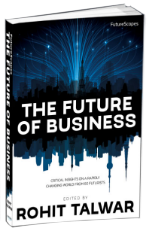04 Oct The Class of 2025 – Smart Kids Who Might Not Be ‘Buying It’?
Appealing to the hearts and minds of the Homelander kids (post-millennials) happens by addressing their taste for technology and modern communication devices. Growing up with touchscreens as the main window to the world, these kids are seriously steeped in a lifestyle and educational agenda that revolves around digital – where technologies are used as learning devices (educational platforms), often through gamified experiences, as well as study objects (coding, programming). For-profit university Ashford University does a good job at mining this sentiment in a commercial featuring children caressing their devices like they did their teddy bears a few years earlier. The message is clear: To be relevant and effective with the class of 2025 education needs to live in the tablets and smart phones, or soon bionic lens projections. The commercial revolves around catchwords like “smart” and “bright”, words recent surveys show cling well in the ears of kid today. So much in fact, that smart as an aspirational goal is overpowering any other superhero power that previous generations of kids used to idolize.
This message is in steep contrast to the realities of higher education today. Recent psychographic surveys show that despite their esteem for smarts, Generation Z/Homelanders are less enthusiastic about going to college. The reason is: kids today are in no hurry to grow up and want to remain kids. They are growing up sheltered and heard, and also experience childhood as a safe place in a world full of turmoil. They are probably unaware of the fact that college tuition increased by 1,120 percent in the same time period that average wages only increased by 11 percent. But they nonetheless sense their parents’ financial difficulties and worries, and see their over-educated older siblings scraping by in a sluggish economy.
The cost increase in education is central to Time Magazine’s current special college report: “Class of 2025: How they Will Learn And What They Will Pay”. While families’ private assets such as income and home value have plummeted, both private and and public university tuitions keep rising. This is partly due to declines in public funding. Writes Phyllis Wise, chancellor of U of Illinois: “Funding for our public universities, which educate 70 percent of all undergraduates has declined to the point where the cost of a college education rests increasingly on the backs of our students.” The problem with funding to universities is actually so severe that the leading edge U.S. education has over other countries is coming to a halt. Actually to the point where it’s leading to a reverse brain drain. Mary-Sue Coleman at U of Michigan claims that while education and research is viewed as an investment in the future in many developing countries, Americans speak of it merely as a cost. Perhaps not so surprising when individual families have to foot the bill of a college education that no longer guarantees ROI? President of MIT Rafael Reif believes the answer lays in free or heavily “discounted” online education, the so-called MOOCs. When online instruction was compared to on-campus learning online came out best in retention of the content. There’s one big caveat though. The study, carried out by Nobel laureate Carl Wieman addressed a situation where online instruction was combined with ‘highly interactive “flipped classrooms“‘. This is a very important distinction from the typical online format that relies heavily on top-down based instruction with very little or no participatory and individualized follow up.
While online education might seem like the golden bucket at the and of the rainbow to those strapped by money, time and geography, critics are scratching at the optical illusions behind its’ highly promoted halcyon prospects. A brand new report from Campaign for The Future of Higher Education says it pretty bluntly in it’s title: Follow the Money. The proliferation of online degrees that promise to make education fit into our busy (read: overworked) lives are billion dollar money machines often often funded with public money.
There has been a gradual development from no public funding of for-profit universities prior to 1998 to a situation where in 2010 a staggering $1.46 billion was allotted to Kaplan alone, thereby accounting for 82 percent of the company‘s higher-education revenue! So what seems to be a funding deficit addressed earlier in this post is rather a rerouting of resources from public to private institutions.
In the our youngest generation’s rather gloomy education prospects, it does indeed look like – regardless of how much they value ‘smarts’, regardless how potentially inclined they would be in pursuing the traditional route to knowledge accumulation – the path ahead are growing over with obstacles. They might become autodidact self learners, home-schoolers in hackerspaces, intuitive masters and mavens of web 2.0+ and natural champions of content creation and self-branding. But education as we know, or at least the most corrupting elements of it, could become extinct if our youngest generation turn out too ‘smart’ to be fooled by empty promises.
Images: George Hodan @ PublicDomainPictures.net; Ashford University



Sorry, the comment form is closed at this time.